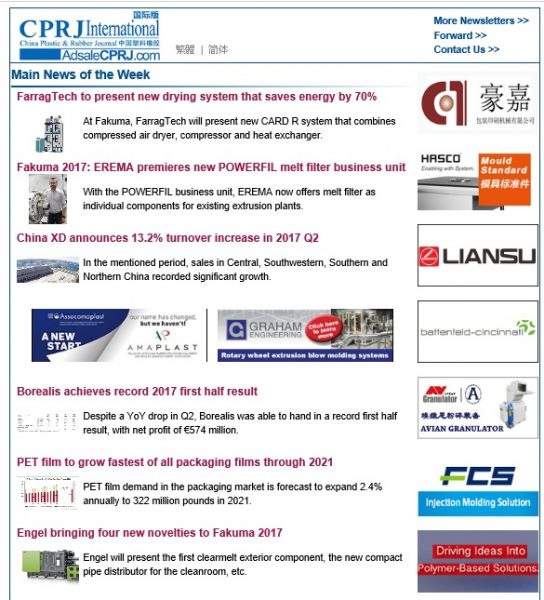 On Wednesday Aug 16th, 2017, the China Plastic & Rubber Journal (CPRJ) published its latest news Journal. The Journal is, like always, transferring the latest plastics and rubber news to its global subscribers and viewers. The following is short description of the new CPRJ Journal.
On Wednesday Aug 16th, 2017, the China Plastic & Rubber Journal (CPRJ) published its latest news Journal. The Journal is, like always, transferring the latest plastics and rubber news to its global subscribers and viewers. The following is short description of the new CPRJ Journal.
Having diverse selected titles from hundreds of news published everyday in the polymer world, the Aug. 16th 2017 news Journal of CPRJ is very eye-catching and informative.
The latest titles include:
- FarragTech to present new CARD R drying system that saves energy by 70% on average;
- Fakuma 2017: EREMA premieres new POWERFIL melt filter business unit;
- China XD announce 13.2% turnover increase in 2017 Q2;
- Borealis achieves record 2017 first half result;
- PET film to grow fastest of all packaging films through 2021;
- ENGEL bringing four new novelties to Fakuma 2017;
- Global demand for plasticizers to reach 9.75 billion tons by 2024;
- Haitian achieves accomplishment in high-end injection moulding machines;
- A feast of automated and intelligent packaging solutions at Sino-Pack;
- Davis-Standard acquires Finland’s Maillefer;
The CPRJ Journal, then, has published a series of articles including:
- European injection Moulding leaders Excel;
- South East Asian plastics industries strengthen position;
- Polyamide demand driven by enhanced performances;
- A plus of flexibility with the new 11-layer concept.
At the above article, for example, the article points to:
In 2014 the worldwide usage of high barrier films reached a market volume of 1.76 million tons with a market value of US$15.9 billion as announced by Smithers Pira’s market report “The Future of High Barrier Packaging Films to 2019”.
Until 2019 consumption is expected to increase by 5% annually. In this context high barrier films are defined as films that are flexible, have a thickness of under 250μm and, at a thickness of 25μm, have an oxygen transmission rate of less than 5cm3/m2/24h.
The reason for the increasing usage of high barrier films is an increase in demand for packaging materials with improved product protection. This is particularly the case for food and drink but also for pharmaceutical products.
To read more please “CLICK HERE“












